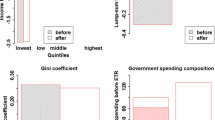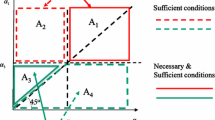Abstract
There has been considerable debate as to whether the revenue-neutral substitution of environmental taxes for ordinary income taxes might offer a double dividend: not only (1) improve the environment but also (2) reduce certain costs of the tax system. This paper articulates different notions of double dividend and examines the theoretical and empirical evidence for each. It also connects the double-dividend issue with principles of optimal environmental taxation in a second-best setting.
A weak double-dividend claim-that returning tax revenues through cuts in distortionary taxes leads to cost savings relative to the case where revenues are returned lump sum-is easily defended on theoretical grounds and (thankfully) receives wide support from numerical simulations. The stronger versions contend that revenueneutral swaps of environmental taxes for ordinary distortionary taxes involve zero or negative gross costs. Theoretical analyses and numerical results tend to cast doubt on the strong double-dividend claim, although the theoretical case is not air-tight and the numerical evidence is mixed.
Similar content being viewed by others
References
Atkinson, Anthony B., and Joseph E. Stiglitz. (1980).Lectures on Public Economics. New York: McGraw-Hill.
Auerbach, Alan J., and Laurence J. Kotlikoff. (1987).Dynamic Fiscal Policy. Cambridge: Cambridge University Press.
Ballard, Charles L., and Don Fullerton. (1992). “Distortionary Taxes and the Provision of Public Goods.”Journal of Economic Perspectives 6(3), 117–131.
Ballard, Charles L., and Steven G. Medema. (1993). “The Marginal Efficiency Effects of Taxes and Subsidies in the Presence of Externalities.”Journal of Public Economics 52, 199–216.
Ballard, Charles L., John B. Shoven, and John Whalley. (1985). “General Equilibrium Computations of the Marginal Welfare Costs of Taxes in the U.S.”American Economic Review 75(1), 128–138.
Bertrand, T.J., and J. Vanek. (1971). “The Theory of Tariffs, Taxes, and Subsidies: Some Aspects of the Second Best.”American Economic Review 61, 925–931.
Bovenberg, A. Lans, and Ruud A. de Mooij. (1992). “Environmental Taxation and Labor Market Distortions,” Working Paper, Ministry of Economic Affairs, The Hague, March. Forthcoming inEuropean Journal of Political Economy.
Bovenberg, A. Lans, and Ruud A. de Mooij. (1994a). “Environmental Levies and Distortionary Taxation.”American Economic Review, September, Vol. 84, No. 4, pp. 1085–1089.
Bovenberg, A. Lans, and Ruud A. de Mooij. (1994b). “Environmental Tax Reform and Endogenous Growth.” Working Paper, Tilburg University.
Bovenberg, A. Lans, and Lawrence H. Goulder. (1994a). “Inegrating Environmental and Distortionary Taxes: General Equilibrium Analyses.” Working Paper, Stanford University, March.
Bovenberg, A. Lans, and Lawrence H. Goulder. (1994b). “Optimal Environmental Taxataion in the Presence of Other Taxes: An Applied General Equilibrium Analysis.” Working Paper, Stanford University, May.
Bovenberg, A. Lans, and F. van der Ploeg. (1993). “Consequences of Environmental Tax Reform for Involuntary Unemployment and Welfare.” Working Paper, Tilburg University, September.
Bovenberg, A. Lans, and F. van der Ploeg. (1994a). “Environmental Policy, Public Finance and the Labor Market in a Second-Best World.”Journal of Public Economics 55, 349–390.
Bovenberg, A. Lans, and F. van der Ploeg. (1994b). “Green Policies in a Small Open Economy.”Scandinavian Journal of Economics 96(3), 343–363.
Brendemoen, Anne, and Haakon Vennemo. (1993). “The Marginal Cost of Funds in the Presence of External Effects.” Discussion Paper No. 99, Research Department, Central Bureau of Statistics, Norway, August.
Carraro, Carlo, Marzio Geleotti, and Massimo Gallo. (1994). “Environmental Taxation and Unemployment: Some Evidence on the Double Dividend Hypothesis in Europe.” Working Paper, GRETA Econometrics, May.
Dasgupta, Partha S., and Geoffrey M. Heal. (1979).Economic Theory and Exhaustible Resources. Cambridge: Cambridge University Press.
Deaton, Angus. (1987). “Econometric Issues for Tax Design in Developing Countries.” In David Newbery and Nicholas Stern, (eds.),The Theory of Taxation for Developing Countries. New York: Oxford University Press.
Diamond, Peter, and J. Mirrlees. (1971). “Optimal Taxation and Public Production I: Production Efficiency and II: Tax Rules.”American Economic Review 61.
Dixit, Avinash. (1975). “Welfare Effects of Tax and Price Changes.”Journal of Public Economics 4(1), 103–123.
Gaskins, Darius, and John Weyant. (1995).Reducing Global Carbon Dioxide Emissions: Costs and Policy Options. Stanford, CA: Stanford University Press.
Goulder, Lawrence H. (1994a). “Effects of Carbon Taxes in an Economy with Prior Tax Distortions: An Intertemporal General Equilibrium Analysis.” Working Paper, Stanford University, July. Forthcoming inJournal of Environmental Economics and Management.
Goulder, Lawrence H. (1994b). “Energy Taxes: Traditional Efficiency Effects and Environmental Implications.” In James M. Poterba, (ed.),Tax Policy and the Economy 8. Cambridge, MA: MIT Press.
Hausman, Jerry A. (1985). “Taxes and Labor Supply.” In A.J. Auerbach and Martin S. Feldstein (eds.),Handbook of Public Economics (Vol. 1). Amsterdam: North-Holland.
Jorgenson, Dale W., and Peter J. Wilcoxen. (1990). “Environmental Regulation and U.S. Economic Growth.”Rand Journal of Economics 21(2), 314–340.
Jorgenson, Dale W., and Peter J. Wilcoxen. (1995). “Reducing U.S. Carbon Emissions: An Econometric General Equilibrium Assessment.” In Darius Gaskins and John Weyant (eds.),Reducing Global Carbon Dioxide Emissions: Costs and Policy Options. Stanford, CA: Stanford University Press.
Jorgenson, Dale W., and Kun-Young Yun. (1990).Tax Policy and the Cost of Capital. Oxford: Oxford University Press.
Kneese, Allen V., and Blair T. Bower. (1968).Managing Witter Quality: Economics, Technology, Institutions. Baltimore: Johns Hopkins Press.
Lee, Dwight, R., and Walter S. Misiolek. (1986). “Substituting Pollution Taxation for General-Taxation: Some Implications for Efficiency in Pollution Taxation.”Journal of Environmental Economics and Management 13, 338–347.
Ligthart, Jenny E., and Frederick van der Ploeg. (1994). “Pollution, the Cost of Public Funds and Endogenous Growth.” Working Paper, University of Amsterdam, October. Forthcoming inEconomic Letters.
Lipsey, R.G., and K. Lancaster. (1956). “The General Theory of the Second Best.”Review of Economic Studies 24, 11–32.
Nichols, Albert L. (1984).Targeting Economic Incentives for Environmental Protection. Cambridge, MA: MIT Press.
Nordhaus, William D. (1993). “Optimal Greenhouse-Gas Reductions and Tax Policy in the ‘DICE’ Model.”American Economic Review 83(2) (Papers and Proceedings), 313–317.
Oates, Wallace E. (1991). “Pollution Charges as a Source of Public Revenues.” Resources for the Future Discussion Paper QE92-05. Resources for the Future, Washington, DC, November.
OECD. (1992).The Economic Costs of Reducing CO 2 Emissions. OECD Economic Studies 19. Paris: OECD.
Parry, Ian W.H. (1994). “Pollution Taxes and Revenue Recycling.” Working Paper, Economic Research Service, U.S. Department of Agriculture, April.
Pearce, David W. (1991). “The Role of Carbon Taxes in Adjuting to Global Warming.”Economic Journal 101, 938–948.
Pezzey, John. (1992). “Some Interactions between Environmental Policy and Public Finance.” Working Paper, University of Bristol, June.
Pigou, A.C. (1938).The Economics of Welfare (4th ed.). London: Weidenfeld and Nicolson.
Poterba, James M. (1991). “Tax Policy to Combat Global Warming: On Designing a Carbon Tax.” In Rudiger Dornbusch and James M. Poterba, (eds.),Global Warming Economic Policy Responses. Cambridge, MA: MIT Press.
Poterba, James M. (1993). “Global Warming: A Public Finance Perspective.”Journal of Economic Perspectives 7(4), 47–63.
Proost, Stef, and Denise van Regemorter. (1994). “Testing the Double Dividend Hypothesis for a Carbon Tax in a Small Open Economy.” Working Paper, Center for Economic Studies, Catholic University of Leuven, Leuven, Belgium.
Repetto, Robert, Roger C. Dower, Robin Jenkins, and Jacqueline Geoghegan. (1992).Green Fees: How a Tax Shift Can Work for the Environment and the Economy. World Resources Institute, November, Washington, D.C.
Sandmo, Agnar. (1975). “Optimal Taxation in the Presence of Externalities.”Swedish Journal of Economics 77, pp. 86–98.
Schöb, Ronnie. (1994). “Environmental Levies and Distortionary Taxation: Environmental View vs. Public Finance View.” Working Paper, Department of Economics, University of Munich, June.
Shackleton, Robert, Michael Shelby, Alex Cristofero, Roger Brinner, Joyce Yanchar, Lawrence Goulder, Dale Jorgenson, Peter Wilcoxen, and Peter Pauly. (1992). “The Efficiency Value of Carbon Tax Revenues.” U.S. Environmental Protection Agency, November, draft manuscript.
Shah, Anar, and Bjorn Larsen. (1992). “Carbon Taxes, the Greenhouse Effect and Developing Countries.” World Bank Policy Research Working Paper Series No. 957. World Bank, Washington, DC.
Sörenson, Peter B., Lars H. Pedersen, and Soren B. Nielsen. (1994). “Taxation, Pollution, Unemployment and Growth: Could There Be a Triple Dividend from a Green Tax Reform?” Working Paper, Economic Policy Research Unit, Copenhagen Business School.
Sweeney, James L. (1977). “Economics of Depletable Resources: Market Forces and Intertemporal Bias.”Review of Economic Studies 44, 125–142.
Sweeney, James L. (1993). “Economic Theory of Depletable Resources: An Introduction.” In Allen V. Kneese and James L. Sweeney, (eds.),Handbook of Natural Resource and Energy Economics (Vol. 3). New York: North Holland.
Terkla, David. (1984). “The Efficiency Value of Effluent Tax Revenues.”Journal of Environmental Economics and Management 11, 107–123.
Tullock, Gordon. (1967). “Excess Benefit.”Water Resources Research 3, 643–644.
Author information
Authors and Affiliations
Rights and permissions
About this article
Cite this article
Goulder, L.H. Environmental taxation and the double dividend: A reader's guide. Int Tax Public Finan 2, 157–183 (1995). https://doi.org/10.1007/BF00877495
Issue Date:
DOI: https://doi.org/10.1007/BF00877495




